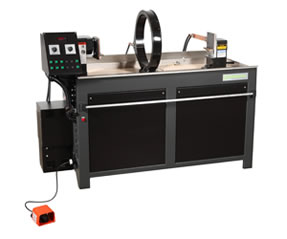 Before a repair quote can be provided to the customer, an inspection of the crankshaft must be made by both a visual examination and with precision measuring instruments. Before this can occur, the crankshaft must be cleaned. Different automotive machine shops use different cleaning techniques, but baking and blasting the crankshaft is a modern process that allows more details to be seen during a visual inspection. Other cleaning processes involve the use of a degreaser machine or acid dip tank. Because of EPA requirements involving the use of hazardous chemicals are quite strict, more shops are using an automotive bake oven (pictured above) and blast process to clean crankshafts.
Before a repair quote can be provided to the customer, an inspection of the crankshaft must be made by both a visual examination and with precision measuring instruments. Before this can occur, the crankshaft must be cleaned. Different automotive machine shops use different cleaning techniques, but baking and blasting the crankshaft is a modern process that allows more details to be seen during a visual inspection. Other cleaning processes involve the use of a degreaser machine or acid dip tank. Because of EPA requirements involving the use of hazardous chemicals are quite strict, more shops are using an automotive bake oven (pictured above) and blast process to clean crankshafts.
With a clean crankshaft, the engine machinist is able to perform an inspection that is both thorough and accurate. At this stage a micrometer is used to determine how far out of tolerance the main and rod journals are. The thrust surface is also measured with a snap gauge and micrometer to determine how much excessive endplay may be present. Providing the crankshaft journals and thrust have available undersize bearings available, or excessive damage can be repaired with a weld, the machinist will then inspect the crankshaft snout, seal surface and rear flange for damage.
Most crankshaft snouts and rear flanges contain threaded holes. Although damage in these areas is rare, they can easily be fixed with the appropriate helicoil. However, the crankshaft snout contains a keyway and key for the harmonic balancer to locate off of. If the key is damaged, it can easily be replaced. But if there is excessive damage to the keyway, which is the machined area that holds the key, it most likely will need to be welded.
Once it has been determined that a crankshaft is thus far a good candidate for repair, it is then placed into v-blocks on the first and last main journals. A dial indicator is then used on the center main journals to detect how much movement there is when the crankshaft is gently rotated. This movement is often referred to as runout by many in the industry. It’s not uncommon to see a dial indicator’s needle move .001-.002” on an ordinary crankshaft. When an excessive amount of movement is detected on the dial indicator, the crankshaft is deemed to be bent. A mild bend can be affordably repaired with a straightening process. But a bend that exceeds .010” or more may be a sign that crankshaft is cracked.
 By visually inspecting a crankshaft, an engine machinist can identify some large cracks. These cracks, which mostly are found in a journal’s radius, often are so small that the human eye can’t see them. Engine machinists often rely on the use of a magnaflux machine (pictured left) that magnetizes the crankshaft so that a special metallic based liquid will join the opposing sections of a crack once magnetized. With the aid of a black light, while the work area is dark, the fluorescent particles may be viewed and are quite noticeable when they gather on a crack. The magnaflux process is both quick and inexpensive, but it does require a great deal of skill in knowing where the cracks are more likely to occur at in the various types of crankshafts.
By visually inspecting a crankshaft, an engine machinist can identify some large cracks. These cracks, which mostly are found in a journal’s radius, often are so small that the human eye can’t see them. Engine machinists often rely on the use of a magnaflux machine (pictured left) that magnetizes the crankshaft so that a special metallic based liquid will join the opposing sections of a crack once magnetized. With the aid of a black light, while the work area is dark, the fluorescent particles may be viewed and are quite noticeable when they gather on a crack. The magnaflux process is both quick and inexpensive, but it does require a great deal of skill in knowing where the cracks are more likely to occur at in the various types of crankshafts.
When the crankshaft has been properly inspected, all areas of interest are documented by the machinist. A quote is then provided to the customer, which often includes a recommendation to grind the crankshaft. If the amount of labor needed to repair the crankshaft is too great, it may be more cost effective to purchase a new replacement.
